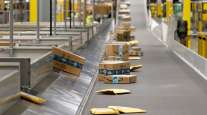GDP Rises 2.3% in Second Quarter; First Quarter Revised Upward

The world’s largest economy expanded at a faster pace in the second quarter and managed to eke out a gain at the start of the year, painting a picture of incremental progress consistent with the Federal Reserve’s view.
Gross domestic product rose at a 2.3% annualized rate, and a revised 0.6% advance in the first quarter wiped out a previously reported contraction, Commerce Department data showed July 30 in Washington. The median forecast of 80 economists surveyed by Bloomberg News called for a 2.5% gain. Consumer spending grew more than projected.
The economy has moved beyond some of the early 2015 constraints, including weather and port delays, while cooling global markets, a strong dollar and insufficient wage gains may continue to limit growth. Fed officials, considering when to begin raising rates this year, concluded on July 29 that the United States is making progress.
“We have plodding, modest yet durable growth,” Michael Gapen, the New York-based chief U.S. economist for Barclays Plc., said before the report. “A gradual raising of rates is reasonable” for the Fed.
Economists’ estimates for GDP, or the value of all goods and services produced, ranged from 1.2% to 3.8%. The growth estimate is the first of three for the quarter, with the other releases scheduled for August and September when more information becomes available.
The Commerce Department also issued its annual revisions, updating the data back through 2012. The first quarter’s reading was revised up from a previously reported 0.2% drop.
The economic expansion over the past three years was weaker than initially projected, with the biggest revision coming in 2013. From the end of 2011 to the end of 2014, the economy expanded at a 2.1% annualized rate, compared to the 2.4% pace reported before. GDP grew 1.5% in 2013, the weakest since the throes of recession in 2009, compared with a previously reported 2.2% gain.
An improving job market is among reasons American households are underpinning economic growth. Consumer spending climbed at a 2.9% annualized rate following a 1.8% advance at the start of the year, the Commerce Department report showed. The Bloomberg News survey median forecast was 2.7%. Purchases added 2 percentage points to growth.
Business spending remained a sore spot, with investment excluding housing falling at a 0.6% rate, the worst performance since the third quarter of 2012.
Government outlays were another source of weakness, rising just 0.8% after dropping 0.1% in the first quarter. A 2% gain among state and local agencies was almost wiped out by a 1.1% drop at the federal level.
Two normally large swing factors, trade and inventories, were fairly stable last quarter and had little influence on growth.
For the first time, the Commerce Department also included a category aimed at providing a measure of private demand in the economy. The gauge reflects consumer and business spending and excludes that by governments as well as exports and inventories. So-called final sales to private domestic purchasers climbed at a 2.5% pace after a 2% gain.
The GDP report also showed price pressures picked up. A measure of inflation, which is tied to consumer spending and strips out food and energy costs, climbed at a 1.8% annualized pace compared with 1% gains in the prior two quarters.
Fed policymakers on July 29 said the labor market and housing have improved, moving closer to ending an unprecedented period of near-zero interest rates without providing a clear signal on the timing of liftoff.
“Economic activity has been expanding moderately in recent months,” the central bank said in a statement. At the same time, “business fixed investment and net exports stayed soft.”
Economists project second-half growth will benefit from purchases by American households, boosted by rising employment and an unemployment rate at a seven-year low.
Automobiles remain a steady source of strength for growth in consumer spending and for factory production. June sales of cars and light trucks capped the strongest quarter since 2005, according to figures from Ward’s Automotive Group.
The residential real-estate market is also in an upswing as low mortgage rates and easier lending requirements encourage prospective home buyers. While the latest data on new home sales was weak, purchases of existing houses rose in June at the strongest pace since February 2007.
Harsh winter weather and West Coast labor disputes caused a slowdown in activity in the first quarter, and cutbacks in oil exploration and drilling in the wake of plunging crude prices also hurt the economy.
There are some signs business investment is set to recover from an early-year malaise, as American factories got more orders for capital goods such as machinery and fabricated metals in June.
Appliance maker Whirlpool Corp. posted second-quarter profit that topped analysts’ estimates, and reiterated its annual earnings forecast.
In contrast, some industrial companies such as Caterpillar Inc. and 3M Co. are hurting because of weak global markets and the lingering fallout from a stronger dollar, even as the woes of the oil sector dissipate.




